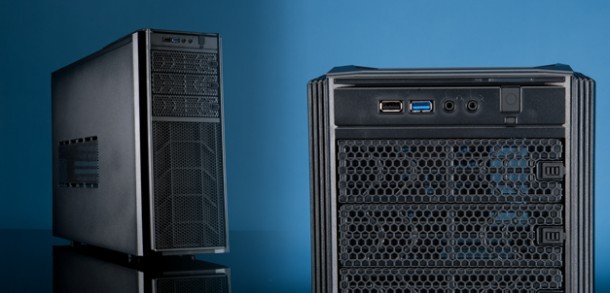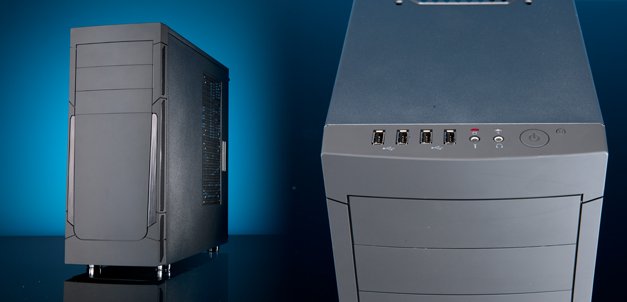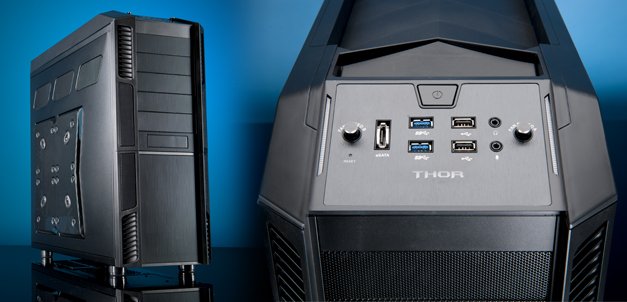
Tempest 210 NZXT
SCORE: 77
The Tempest 210 isn't all that large, measuring in at 19.3 inches deep, 17.9 inches tall, and 7.7 inches wide. It does manage to squeeze in a decent amount of stuff for its size, though, including two fans (a 14cm top exhaust fan and 12cm rear exhaust fan) with support for five more. There are seven PCI expansion slots, and although it comes with just three optical drive bays, it does include eight toolless hard drive bays and an SSD mount at the bottom of the case.
Three cable-routing cutouts keep the wiring neatly organized behind the motherboard, and the case accommodates extra-long graphics cards, though at the expense of some hard drive mounts. Building into the Tempest isn't too tricky, although the cutout for the 8-pin CPU power cable is barely usable. The Tempest is still definitely a budget case. Its front panel connectors include just one USB 2.0 and one USB 3.0 port, and the hard drive mounts are a little on the flimsy side. On the other hand, two fans are better than one, and given that, for budget standards, it has slightly roomier confines and better stock cooling-performance, it should definitely appeal to some.

Outlaw BitFenix
SCORE: 74
BitFenix's Outlaw is a petite steel midtower case with a restrained, refined aesthetic. The BitFenix signature “SofTouch” coating is restricted to the front panel, while the rest of the case is painted matte black inside and out. So why is it it called the Outlaw? Probably because the motherboard mounts upside down. The Outlaw has four hard drive bays, four optical bays, and room for one SSD at the bottom of the chassis, and the hard drives and optical drives attach with thumbscrews. The case has seven PCI expansion slots. Though it has mounts for seven additional 120mm fans (two each on the top, front, and side panel and one on the bottom), the Outlaw only ships with one 12cm exhaust fan.
The biggest gaming news, reviews and hardware deals
Keep up to date with the most important stories and the best deals, as picked by the PC Gamer team.
The odd motherboard placement works well for the Outlaw—long video cards easily clear the top of the hard drive compartment. Spare power cables fit behind the hard drive trays, so a clean-looking install is pretty easy. Though small (18.9 inches deep, 17.3 inches tall, 7 inches wide), the Outlaw is a good choice for a budget build. If USB 3.0 and multiple fans are must-haves, though, look elsewhere, cowboy—the four front-panel USB ports are 2.0 only.

Thor v12 Rosewill
SCORE: 88
Rosewill's Thor v2 is aptly named. It's big, it's burly, it's heavy, and it's really roomy. OK, my metaphor just broke down, but the Thor is huge on the outside and even bigger on the inside, and packed with features that are standard on cases twice or thrice its price. How nice! The Thor can accommodate motherboards in Micro ATX, ATX, E-ATX, and XL-ATX form factors. Its motherboard tray has squillions of rubber-grommeted cable routing holes to make wiring your case a snap, and it also comes with three 23cm fans and one 14cm fan, with two variable-speed controllers that can control up to three fans each. Six hard drive trays and six optical drive trays mean the Thor can handle all your storage and optical drives, with room left for a water reservoir or two.
Building a system into the Thor is easy, and the stock fans keep your rig cool while running quietly. You can swap the top 23cm fan for a dual 120mm or 140mm radiator (if water-cooling's your thing), or stick four 12cm fans on the side panel for massive intake. The top has cooling vents that can open and close, though I can't imagine closing them unless you take out the top fan. The Thor's build quality can't quite match top-tier full towers like Corsair's 800D or Silverstone's TJ11, and its front-panel connectors can get in the way a bit, but it's solid enough, easy to build into, and keeps your components cool quietly. For the gamer who has everything (and wants to put it all into the same build), the Thor v2 is a good case for surprisingly low price.
Carbide 400R Corsair
SCORE:83
Corsair is known for cases that are stylish, well built, and on the pricey side. The Carbide series is aimed at the budget-conscious—and $99 is cheap for a Corsair case. The Carbide 400R is a midtower, although at 20.5 inches deep by 19.2 inches tall by 8.1 inches wide, it's slightly larger than the BitFenix or NZXT cases in this roundup, and it feels much larger inside. The 400R contains two 12cm front intake fans and a 12cm exhaust fan, with five additional 12cm/14cm fan mounts, and the top panel can accommodate a 240mm radiator. The front and bottom panels have removable dust filters.
The 400R's four optical drive bays are toolless, and the six removable hard drive trays have toolless hard drive mounts, though screws are still required for SSDs.
The motherboard tray has four rubber-grommeted cutouts for cable routing, and in true Corsair tradition, hardware installations and cable routing are extremely easy, with plenty of room behind the right side panel for cabling. The case easily supports the longest graphics cards. The 400R's front panel contains two USB 3.0 ports (with pass-through cable and USB 2.0 adapter), FireWire, and audio jacks, as well as a switch for the front fan's white LEDs. At twice the price of the Tempest or Outlaw, the 400R might be too much for the extremely budget-conscious, but it has Corsair's build quality and ease of use, though there are certainly $100 cases that offer more bang for the buck.
PC Gamer is the global authority on PC games—starting in 1993 with the magazine, and then in 2010 with this website you're currently reading. We have writers across the US, Canada, UK and Australia, who you can read about here.



